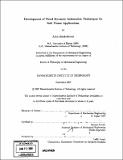| dc.contributor.advisor | Simona Socrate. | en_US |
| dc.contributor.author | Balakrishnan, Asha, 1974- | en_US |
| dc.contributor.other | Massachusetts Institute of Technology. Dept. of Mechanical Engineering. | en_US |
| dc.date.accessioned | 2009-03-20T19:56:14Z | |
| dc.date.available | 2009-03-20T19:56:14Z | |
| dc.date.copyright | 2007 | en_US |
| dc.date.issued | 2007 | en_US |
| dc.identifier.uri | http://hdl.handle.net/1721.1/42987 | |
| dc.description | Thesis (Ph. D.)--Massachusetts Institute of Technology, Dept. of Mechanical Engineering, 2007. | en_US |
| dc.description | Includes bibliographical references (leaves 141-149). | en_US |
| dc.description.abstract | Realistic material models to simulate the behavior of brain tissue at large deformations and high strain rates are necessary when designing equipment to protect against ballistic impacts. Acquiring experimental data for brain tissue response is critical to developing appropriate models. Current in vivo and in situ procedures for testing the material behavior of soft tissues are dominated by indentation techniques. The major challenge for this testing configuration is in finding a unique solution to the "inverse problem" i.e., obtaining material properties that are uniquely defined by the indentation force-displacement response. Much of the information related to the interplay between shear and bulk compliance in the deformation field beneath the indenter is lost when capturing the single force-displacement output. To address this challenge, we propose a material testing technique that follows the well- proven path of conventional indentation methods, but also enriches the signal by acquiring displacement data for an offset, passive surface tracking sensor. We present the results of a finite element (FE) study to demonstrate that the addition of a secondary sensor can help to discern between materials with varying degrees of compressibility. To this end, a large displacement in vivo dynamic indentation surface tracking (DIST) tool was designed and manufactured. This tool incorporates the secondary sensor concept to measure the force-displacement response of brain tissue at strain rates up to 1000%/s. The technique is applied in vitro to measure the response of porcine brain tissue. To select an appropriate constitutive framework for porcine brain tissue in vitro, uniaxial compression tests measuring the corresponding lateral stretch response are performed. | en_US |
| dc.description.abstract | (cont.) A three-dimensional large deformation constitutive model for brain tissue is developed. The model accounts for the observed features of the material response including non-linearity, conditioning, hysteresis, and strain-rate dependence. The model is incorporated into an FE simulation of the brain indentation tests performed with the DIST tool. The effectiveness of the DIST as a material-testing tool is assessed. | en_US |
| dc.description.statementofresponsibility | by Asha Balakrishnan. | en_US |
| dc.format.extent | 149 leaves | en_US |
| dc.language.iso | eng | en_US |
| dc.publisher | Massachusetts Institute of Technology | en_US |
| dc.rights | M.I.T. theses are protected by
copyright. They may be viewed from this source for any purpose, but
reproduction or distribution in any format is prohibited without written
permission. See provided URL for inquiries about permission. | en_US |
| dc.rights.uri | http://dspace.mit.edu/handle/1721.1/7582 | en_US |
| dc.subject | Mechanical Engineering. | en_US |
| dc.title | Development of novel dynamic indentation techniques for soft tissue applications | en_US |
| dc.type | Thesis | en_US |
| dc.description.degree | Ph.D. | en_US |
| dc.contributor.department | Massachusetts Institute of Technology. Department of Mechanical Engineering | en_US |
| dc.identifier.oclc | 232155981 | en_US |
